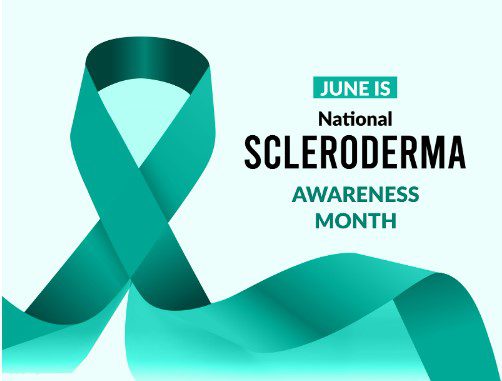Search by Color or Cause


National Scleroderma Awareness Month takes place in June. For this reason, during June we raise awareness of scleroderma across the media and the general public. We also provide information about symptoms to know. The awareness color for scleroderma is teal. For this reason, wear a teal awareness pin, fabric ribbon, or teal silicone wristband to raise awareness about scleroderma.
Sclero” means “hard” and “derma” means “skin”. However, hardening skin is just one of many symptoms scleroderma sufferers experience. In addition, stiff joints, digestive issues, lung scarring, and kidney failure can all be part of scleroderma. Further, National Scleroderma Awareness Month highlights that scleroderma is an autoimmune disease with no known cause or cure. For this reason, research is vital. Because so few people are aware of the disease, research is lacking. Learn more about scleroderma. Likewise, help raise awareness.
‘Scleroderma’ is an umbrella term that refers to the various different types of this rare and complex condition. For example, hardening of the skin is often the first sign that people notice. This occurs because the body is producing too much collagen.
It is thought that around 2.5 million people worldwide are affected by scleroderma. Scleroderma can range from mild to severe and in some cases may even become life-threatening. It is important to remember that every story is unique and that no two cases are ever identical. For example, how an individual will be affected by their condition will depend upon the type of scleroderma they have.
There are two main types of scleroderma: localized and systemic. First, localized scleroderma will mainly affect the skin, and for many people this will be a milder form of the disease. Secondly, in systemic scleroderma (systemic sclerosis), some of the internal organs are involved, as well. These include the heart, lungs or kidneys. Raynaud’s Phenomenon is often a common symptom of both types of scleroderma.
Everyone’s experience of scleroderma is different. It depends on what type you have, how severe it is, and what parts of your body are affected. For most people, scleroderma causes problems with the skin.
These symptoms can include:
In addition, you can develop painful sores on your fingers and toes, called digital ulcers. These must be treated right away to protect the tissue and prevent an infection.
Alongside scleroderma, it is common to have a condition called Raynaud’s Phenomenon. People with Raynaud’s are sensitive to temperature changes or cold. This can cause tingling, discomfort or pain. This usually occurs in the hands and feet. Fingers or toes might turn from white, to blue, to red. Stress and anxiety are sometimes a trigger.
Morphoea is the name given to localized patches of hardened skin that appear smooth and shiny. They usually appear on the trunk, but they can affect any part of the body. The condition is painless and there are normally no other symptoms or additional problems.
‘Linear’ scleroderma means that the skin is affected in the form of a line, usually along an arm or a leg. The skin appears shiny, discolored or scarred. It often feels tight and uncomfortable. In children, this should be monitored carefully because the ongoing growth of the limb can be affected.
En coup de sabre‘ literally means ‘cut of a sword’. This form of scleroderma presents on the scalp and temple in children. If the affected area is confined to the scalp then the problem is mainly cosmetic. However, the underlying bone may be affected.
Parry Romberg Syndrome also affects children and presents on the face, and occasionally, the tongue. This requires careful monitoring as it may affect the growth of the facial bones.
There are two types of this condition:
With limited systemic sclerosis, a person may have lived with Raynaud’s for a long time. It often progresses gradually, and usually only affects the face, hands, arms below the elbows, feet and legs below the knees. The lungs and digestive system may become involved over time.
Diffuse systemic sclerosis is more likely to affect the whole body, and in some cases there can be potentially serious complications involving the heart, lungs and kidneys. Common symptoms include fatigue, joint pain, and stiffness.
Researchers don’t completely understand what causes scleroderma. It is thought, however, to be an autoimmune disease. This means your immune system, which usually fights off infections, goes wrong and starts attacking the tissues in your body. With scleroderma, this leads the body to create too much collagen. As a result, the skin and sometimes the blood vessels and other parts of the body stiffen up. This is a process called fibrosis
For many people, symptoms can be managed effectively. Some individuals who are more severely affected may be more restricted by their condition.
One of the frustrating things about scleroderma is that getting a diagnosis is not always straightforward. Because it’s a rare disease, it’s possible an internist has never seen a case before. And many other conditions can have similar symptoms. Unfortunately, there’s not a test that can tell, on its own, whether you have scleroderma or not. A specialist, typically a rheumatologist, must put together lots of different information to confirm that you have the condition. They also need to determine what type of scleroderma you have. They also need to identify which parts of your body are being affected.